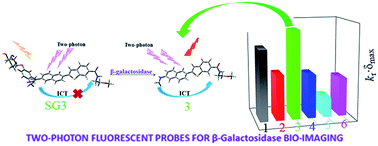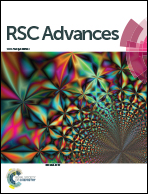Theoretical investigation and design of two-photon fluorescent probes for visualizing β-galactosidase activity in living cells†
Abstract
As a marker enzyme, the underlying biological mechanisms of β-galactosidase (β-gal) and its role in senescence and aging still remain unknown. Two-photon (TP) fluorescence microscopy (TPFM) is a promising approach for detecting β-gal enzyme activity in living specimens. In the present study, we have firstly designed a series of novel naphthalene-based β-gal ratiometric TP fluorescent chromophores, and carried out quantum-chemical calculations on their structural and linear/nonlinear optical properties. We have thoroughly studied the effects of different biological bridge groups (quinoline, benzo[d]thiophene, thiophene, diazine) and cyano groups on the one-photon absorption (OPA), fluorescence, as well as two-photon absorption (TPA) properties of β-gal probes and the corresponding reaction products. The calculated results show that the product molecules always exhibit longer absorption and emission wavelengths, and possess both stronger TP transition probability and a larger net charge change relative to that of corresponding β-gal probes, due to their better planarity and larger transition dipole moment. Our analysis suggests that the net charge change dominates the TPA cross section (δmax). There is an optimal match for δmax and radiation rate (kr) following the increase of the net charge change to improve nonlinear optical activity in the studied molecules. The substitution of benzo[d]thiazole with benzo[d]thiophene is an optimal approach for β-gal probe design with the largest fluorescence efficiency and δmax. We hope this contribution can provide detailed theoretical analysis of OPA and TPA properties of β-gal probes and relevant products, and provide insight into the structure–property relationships for guiding experimental design.


 Please wait while we load your content...
Please wait while we load your content...